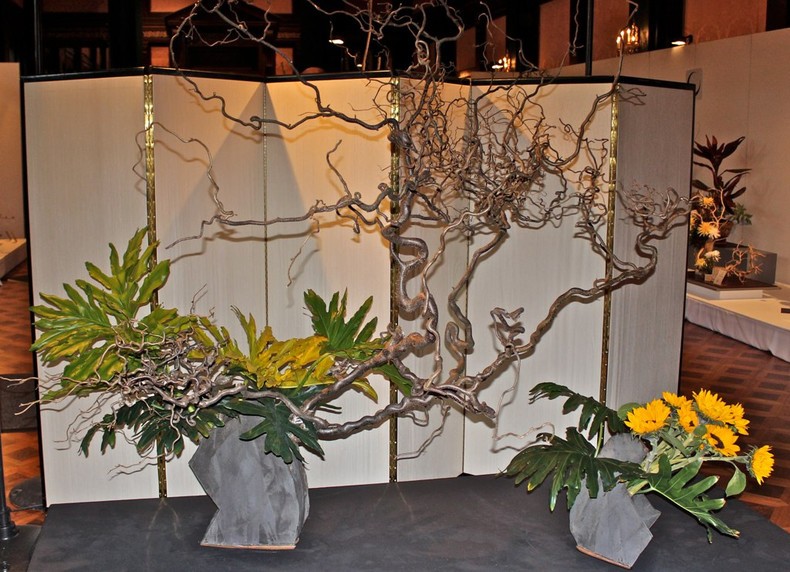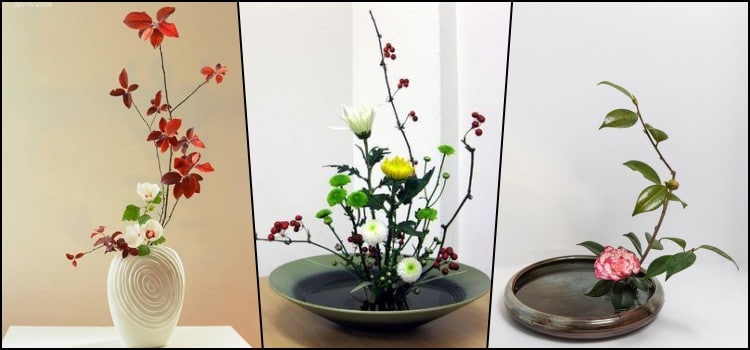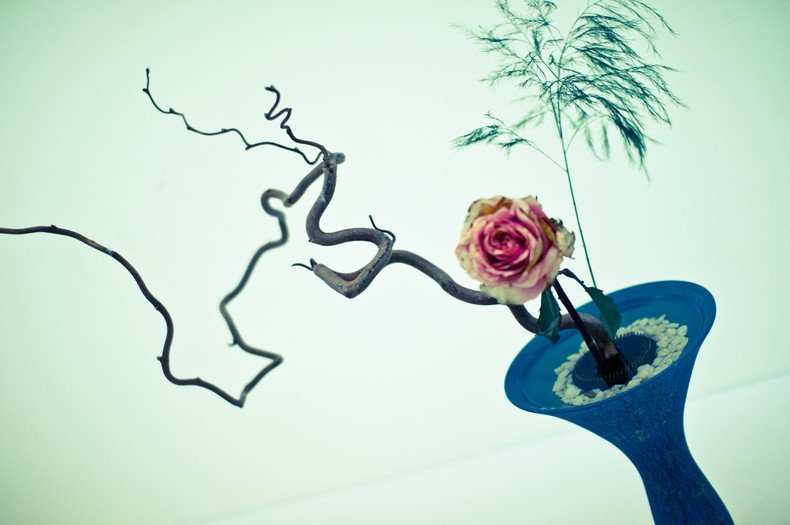Ikebana is an ancient art, created and spread in Japan in the 7th century, whose objective is based on arranging flowers, leaves and natural branches in full harmony with the vases and thus giving life to the flower. Ikebana is a very popular art in Japan and Brazil, so we put together this complete article talking all about Ikebana.
Ikebana [生け花] literally means live flowers, a Japanese art focused on flower arrangement. She is also known by the name of Kadou [华道] which means “flower path“, resembling the name of a martial art.
The art of ikebana is known for its focus on stems and leaves, rather than the flowers themselves. Thus creating a floral arrangement with linear, rhythmic, and colorful harmony. In the art of ikebana, there is an aim to portray the existing balance in the universe, uniting heaven (shin), man (soe), and earth (tai or hikae) within the same arrangement.
Kadou is counted as one of the three classical Japanese arts of refinement, along with Kodou who likes incense and Chado which involves tea ceremony.
Table of Content
History and origin of Ikebana
Ikebana originated in India, where religious people made large decorations for the Buddha's altar as an offering. It was the Japanese who made the practice known in the world, and extended it as a type of art practiced by nobles.
Ancient documents record Lotus Ikebana being offered to the Buddha in the Todai Temple ceremonies. Another record called Manyoshu, cataloged 166 types of flowers like hagi and ume that are used to make Ikebana.
Other data claims that this art does not just have a religious symbol. Ikebana also served as entertainment for the residents of the imperial household before Zensai Awase cocktails in the Heian Era.

In the book Manyôshû, the names of 166 types of flowers are cataloged, such as Hagi and Ume. There is also confirmed data that ikebana served as a type of entertainment for the residents of the Imperial House before cocktails (Zensai Awase) in the Heian Era.
The ikebana is always composed of all parts of a plant, such as stems, leaves, flowers, and branches, which according to the Japanese symbolize heaven, earth, and humanity.
Like most traditional Japanese arts, it gradually lost space and tradition. Fortunately, Ikebana was fully promoted as a decorative flower art, gaining strength in the decoration of places.
Styles and Types of Ikebana
In the beginning, Ikebana was very simple, just a few stems and green branches were needed to make an arrangement that was called kuge [供華]. Over time, the imperial families and their retainers evolved the art of ikebana, thus generating various styles and types that we will list below:
- Ikenobo - The oldest style, are arrangements with devotion to the gods, and are decorated with twigs;
- Sogetsu - One of the newest styles, as even Queen Elizabeth II and Princess Diana attended schools to learn this technique;
- Ohara – A composition of branches and flowers almost stacked;
- Sanguetsu - Involves not modifying the materials used (leaves, flowers, branches), creating a more natural arrangement;

Rikka [立花] – Reflects the splendor of nature and its display. Used for decoration at parties and ceremonies. The name rikka literally means standing flowers. The key to this style are nine branches that represent elements of nature.
Shoka [生花] – Consists of three main branches that symbolize heaven, man and earth. It represents perpetual change and renewal. Its name means pure flowers, its purpose is to show the beauty and uniqueness of the plant itself.
Moribana [盛花] – It means stacked flowers, which are usually in a shallow vase or suiban, fixed to a Kenzan.
Jiyūka [自由花] – Means free flowers, it consists of a creative and free project without rules reflecting the free style and modernism.
Nageirebana [投入花] – An unstructured style that led to the development of Seika and Shoka.
Each style follows a specific set of rules and techniques when creating the floral arrangement.
The schools in Ikebana
The art is so popular in Japan that it has gained worldwide fame generating more than 3,000 ikebana schools around the world with more than 15 million practitioners of the Japanese flower arranging art.
Ikebana schools are usually led by an iemoto, a rigorous hierarchical system that is often passed down by family members to ensure a particular tradition, which unfortunately ends up being seen as static and restrictive.
Schools are usually related to styles. Some schools have their own style or have helped to develop a certain style. For example, ikenobo is a developed style of rikka, but it also refers to the name of the school.
Ikenobo is the oldest ikebana school that dates back to the 700s and marks its beginnings along with Rokkakudo Buddhist temple in Kyoto. This school and style gave rise to several other schools such as:
- Higashiyama-Ryu
- No-ryu
- Enshiu-Ryu
- Seizan-Ryu
- Misho-Ryu
- Ir-Ryu Saga;
- Shōgetsudo Ko-Ryu;
- Ryu-Ko;
- Senzan-Ryu
- Higashiyama-Ko-Sei-Ryu
- Ryu-Higashiyama
- Soami-Ryu
- Nihonbashi Enshu
- Shin Enshu
- Ango Enshu
- Miyako Enshu
- Seifu Enshu
- Asakusa Enshu
- Sōgensai
- Murakumo-Ryu
- Toko-ryū
- Shikishima-Ryu
- Donin-Ryu

These are some of the schools formed over the years from 700 to 2000. Not to mention the numerous small schools or schools that have spread around the world in different ways, thus generating different styles.
If you're looking for an Ikebana course, you can find places in Brazil that teach ikebana sanguetsu. The Brazil-Japan Cultural Alliance also offers Ikebana classes in the Ikenobo or Sogetsu styles.
How is a Japanese ikebana floral arrangement made?
To make an ikebana you use a simple vase, a kenzan (metal ring to hold the flowers), water, flowers, branches, and stems, and scissors. With these simple tools, you can create your own floral arrangement.
We recommend looking for long, straight, thin branches and branches with few leaves and buds. Of course, it all depends on the style of ikebana you want to create. Some are simple and delicate, others are terribly complex and laborious.

The Ikebana is a front-facing arrangement, so most of the time it will be placed next to a wall. They are often placed in an entrance hall or drawing room to welcome visitors and customers.
As flowers are fragile, the longest a flower arrangement lasts is about a week. Another common, but not exclusive, aspect present in ikebana is the idea of minimalism. A lot of discipline and patience is required.
If you want to delve deeper into the world of ikebana, there is an association in Brazil located in Liberdade – SP. If you are in Japan, the most famous schools are Ikenobo, Ohara and Sogetsu.
Vases, books and Ikebana products
Maybe you are looking for a book about Ikebana, or maybe you want to buy a vase for your ikebana. We took some links from partner sites and put together a catalog of products related to Ikebana for you to take a look at below:
Make your own ikebana
The Japanese art of flower arranging is practiced in complete silence and is thought to refine the practitioner's patience and aesthetic sense. As art is highly appreciated in Japan, it is easy to find events in cities like Tokyo and Kyoto.
Many regard art as a reasonably common pastime across the country. Its simplicity and complexity helps to understand how the human faces his life, the nature around him and his interaction with the divine and transcendental being.
And what do you think of this art? Thanks for the comments and shares! Finally, let's leave a video showing how to make an Ikebana! We recommend reading other articles such as:
